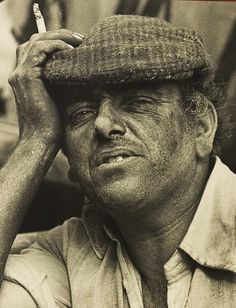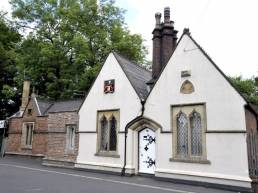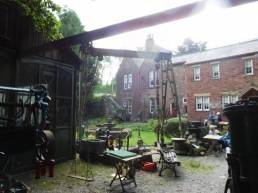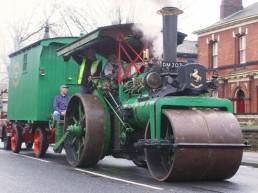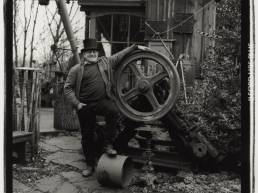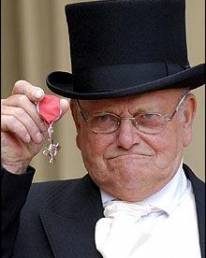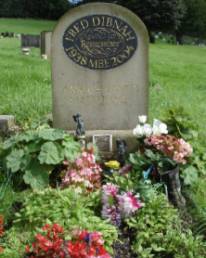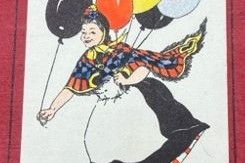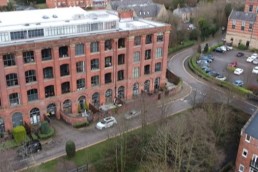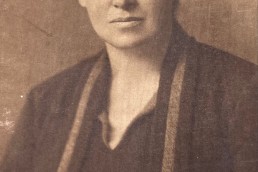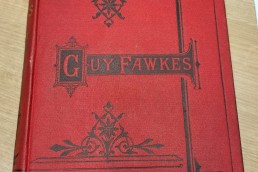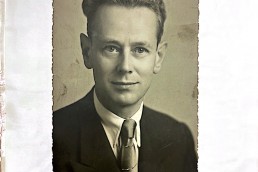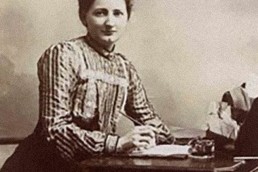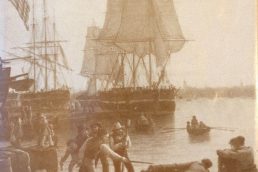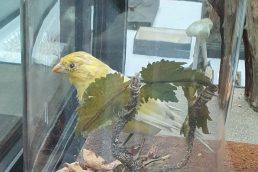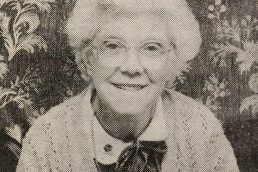This blog post examines the life and work of Fred Dibnah, a Bolton-born steeplejack, draughtsman, stonemason, demolition expert, carpenter, intuitive engineer, steam enthusiast, devotee of our industrial heritage, television personality, and revered son of Bolton, Lancashire. He was every brick, nut and bolt, a late, but most worthy, Victorian (1938-2004).
The details provided below are informed by research located from various sources such as: The Bolton News, Flickr, The Yorkshire Post, Pressreader, National Portrait Gallery, together with various other online sources (see bibliography, below).
Frederick Travis Dibnah was born in a row of terraced houses in Alfred Street, Bolton, Lancashire, to a pair of factory bleach workers, Frank and Betsy Dibnah. As a child, Dibnah was fascinated by the sights and sounds of industry and the dozens of chimney stacks visible around the Bolton skyline. After spells at college studying machinery and engineering, at the age of 16 he left education and was offered a job at a funeral parlour but left quickly to take up joinery. However, Dibnah remained fascinated by the local steeplejacks, and one night on a drunken walk home with some pals, Dibnah was goaded to climb the 262-foot (80m) chimney at Barrow Bridge, Bolton, of which he scaled with ease, winning a bet of 10 shillings, even sticking a union jack on the top of the chimney for show, causing a right stare within the town. Fuelled by this and the love of climbing, Dibnah scaled his mother’s roof and replaced the standard chimney stack with his own ideas of chimney design, making it three times as tall. This stack could be seen for miles and still has a preservation order to this day.
‘He clapped that chimney on the roof when he was sixteen, I’ve had to live with it ever since. It’s awful. I came home from work and there it was, sticking up in the sky. A photographer came from the Evening news. People drove here on a Sunday afternoon to stare at it. Everyone said that Fred was a lunatic.’
Betsy Dibnah, Mother. [Date Unknown]
National Service came calling and at age 22, when Fred was posted first to Aldershot, then to Catterick to learn the basics of army catering, and then to West Germany where he persuaded his commanding officer to allow him to ‘repair things’ instead of cooking. Returning home to Bolton, Fred bought his own set of ladders and lived on small domestic jobs. But his luck changed when he was commissioned to point a local mill tower. Fred then borrowed money from a friend and formed a partnership, and whilst working on the tallest building in Bolton, The Parish Church, Fred repaired and gilded the weathervane, when he appeared in the local newspaper; publicity quickly spread. Bigger and more challenging jobs came calling, and his ladder collection grew to around 30. Eventually, Fred married and moved into a former Victorian gatehouse on Radcliffe Road, Bolton (see above) where people from all over the world have continued to flock to witness Fred’s wonderful and industrious yard/workshop. The above images display Fred Dibnah’s family home, a former Victorian gatehouse based on Radcliffe Road, Bolton. After Fred’s death, the house, together with his infamous back yard/workshop, where Fred forged, engineered, and created many inventions, became a heritage centre until it was sold to a private investor. Here we can also see Fred’s beloved Steam Roller, Betsy, named after his late mother, Betsy.
Having mastered his trade of repairing chimneys, Fred found a cost-effective way of demolishing them (without using explosives). Throughout Lancashire and beyond, a great number of mill chimneys were no longer needed, so Fred pathed the way and demolition began. This made Fred the famous steeplejack we all know and love. So much so, the BBC decided to film a series on his steeplejack escapades titled The Fred Dibnah Story (1996).
Another great insight into the work of Fred Dibnah can be located here (The Day Fred Dibnah Brought Down the Ballyclare Paper Mill Chimney).
Fred continued to celebrate the work of England’s Victorian heritage through multiple BBC broadcasts, such as: Fred Dibnah’s Age of Steam and Fred Dibnah’s Buildings of Britain. In 2004, Fred was awarded an MBE (Member of the British Empire). However, that same year, at the age of 66, Fred Dibnah passed away on the 6th November 2004 at a Bolton Hospice, surrounded by his family. He was laid to rest at Tonge Cemetery, Bolton, Lancashire.
Bibliography
Anon (Date Unknown) Fred Dibnah’s Age of Steam [Online Film] Available at: <https://youtu.be/X_UrJI72Vsc> [Accessed 28th April 2021].
Anon (2007) Fred Dibnah’s house, Radcliffe Road, Bolton. The Bolton News. [Online] Available at: <https://images.app.goo.gl/UfuL7Q2cLDr7ZwUF6> [Accessed 28th April 2021].
Anon (2013) Fred Dibnah’s Steam Roller, Betsy. The Bolton News. [Online] Available at: <https://images.app.goo.gl/JojzvZmfmwHwFyHCA> [Accessed 28th April 2021].
Anon (Date Unknown) Photograph of Fred’s Back Yard/Workshop. Tripadvisor. [Online] Available at: <https://images.app.goo.gl/8z7cK6Hy97b2qAPK7> [Accessed 28th April 2021].
Anon (2016) The Day Fred Dibnah Brought Down the Ballyclare Paper Mill Chimney. [Online] Available at: www.loveballyclare.com>history>the-day-fred [Accessed 28th April 2021].
Anon (1996) The Fred Dibnah Story [Online Film] Available at: <https://youtu.be/wffv8YeoeeM> [Accessed 28th April 2021].
Ogilvie. I. (Date unknown) Photograph of Fred Dibnah. [Online photograph] Available at: <https://images.app.goo.gl/6RcdTR8xNW7unLCa6> [Accessed 28th April 2021].
Skilbeck. B. (2003) Photograph of Fred Dibnah’s childhood home/chimney stack. [Online photograph] Available at: <https://images.app.goo.gl/oJyvDYozsLcd6KKJ6> [Accessed 28th April 2021].
Webster, Wolfgang. P (2008) Fred at the back of Bolton home. National Portrait Gallery. [Online photograph] Available at: <https://images.app.goo.gl/vc2rNx3iyhAP355a8> [Accessed 28th April 2021].
Bibliography
Colby, Robert A. (1985) “Tale Bearing in the 1890s: The Author and Fiction Syndication”. Victorian Periodicals Review. Vol.18, No.1, pp. 2-16.
Hilliard, Christopher (2009) “The Provincial Press and the Imperial Traffic in Fiction, 1870s-1930s”. Journal of British Studies. Vol.48, No.3, pp. 653-673.
Johanningsmeier, Charles (1995) “Newspaper Syndicates of the Late Nineteenth Century: Overlooked Forces in the American Literary Marketplace”. Publishing History. Vol. 37, No.1, pp. 61-82.
Jones, Aled (1984) “Tillotson’s Fiction Bureau: The Manchester Manuscripts”. Victorian Periodicals Review. Vol.17, No.1, pp. 43-49.
Singleton, Frank (1950) Tillotson’s 1850-1950: Centenary of a Family Business. Bolton: Tillotson & Son Ltd.

